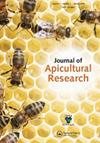Present state and perspectives in analytical methods for pesticide residues analysis in bee pollen: an overview
IF 1.8
4区 农林科学
Q2 ENTOMOLOGY
引用次数: 1
Abstract
Abstract Pollen is a set of pollen grains with a microscopic structure derived from plants. In addition to being the main source of nutrition for bees, pollen has also recently become an important part of the food, cosmetic, and pharmaceutical industries. Pollen is gaining attention as a functional food as well as an important sample that has the potential to bioindicate the presence of contaminants in the environment, enabling monitoring of large areas due to the long distances traveled by bees. Pollen matrix is complex and complicated for analysis, therefore, its influence on analytes in samples must be considered. High yields of pesticide residues can be ensured by selecting a suitable sample preparation method, which includes extraction of analytes and purification of extract. A quick, easy, cheap, effective, rugged, and safe method (QuEChERS), which is the most applicable method for the determination of pesticide residues in bee pollen samples, includes an extraction step using extraction salts (MgSO4, NaCl) whose function is to separate the aqueous phase from the organic phase. The next step of QuEChERS is sample purification by using dispersive solid phase extraction (dSPE). The dSPE method combines various sorbents depending on the type of analytes and the effects of the observed matrix. Other techniques used to extract pesticide residues from bee pollen are ultrasonic-assisted extraction, solid phase matrix dispersion, and the mini-salt-liquid extraction technique (SALLE). Gas chromatography (GC) or liquid chromatography (LC) is most commonly used in combination with mass spectrometry (MS/(MS)) employing various mass analysers to determine pesticides.蜂花粉中农药残留分析方法的现状与展望
摘要花粉是从植物中提取的一组具有微观结构的花粉粒。花粉除了是蜜蜂的主要营养来源外,最近也成为食品、化妆品和制药行业的重要组成部分。花粉作为一种功能性食物和一种重要的样本越来越受到关注,它有可能在生物上表明环境中存在污染物,从而能够监测由于蜜蜂长途旅行而产生的大面积污染。花粉基质的分析是复杂的,因此必须考虑其对样品中分析物的影响。通过选择合适的样品制备方法,包括分析物的提取和提取物的纯化,可以确保农药残留的高产率。一种快速、简单、廉价、有效、坚固和安全的方法(QuEChERS)是测定蜂花粉样品中农药残留的最适用方法,包括使用提取盐(MgSO4、NaCl)的提取步骤,其功能是将水相与有机相分离。QuEChERS的下一步是使用分散固相萃取(dSPE)纯化样品。dSPE方法根据分析物的类型和观察到的基质的影响结合了各种吸附剂。从蜂花粉中提取农药残留的其他技术有超声波辅助提取、固相基质分散和微盐液提取技术(SALLE)。气相色谱(GC)或液相色谱(LC)最常用于与质谱法(MS/(MS))结合使用,质谱法采用各种质量分析仪来测定农药。
本文章由计算机程序翻译,如有差异,请以英文原文为准。
求助全文
约1分钟内获得全文
求助全文
来源期刊
CiteScore
4.80
自引率
10.50%
发文量
111
审稿时长
6-12 weeks
期刊介绍:
The Journal of Apicultural Research is a refereed scientific journal dedicated to bringing the best research on bees. The Journal of Apicultural Research publishes original research articles, original theoretical papers, notes, comments and authoritative reviews on scientific aspects of the biology, ecology, natural history, conservation and culture of all types of bee (superfamily Apoidea).

 求助内容:
求助内容: 应助结果提醒方式:
应助结果提醒方式:


